
Animal Symbolism in Mythology
Animal Symbolism in Mythology
Mythology has always been a treasure trove of fascinating stories and symbolism. Among the many intriguing elements, animal symbolism holds a significant place. Animals have long been an integral part of human culture, and they have often represented various qualities, characteristics, and emotions in mythological tales.
One of the most widely recognized symbols is the wise owl, representing wisdom, knowledge, and intelligence. In Greek mythology, the owl was associated with the goddess Athena, the goddess of wisdom. The association between owls and wisdom can be found in various cultures around the world.
The lion, known for its strength, courage, and nobility, is another powerful symbol in mythology. In many ancient civilizations, including Egyptian and Greek cultures, the lion was often associated with gods and rulers. The Nemean Lion, a legendary creature in Greek mythology, represents the mighty power of nature.
The snake, often depicted as both a positive and negative symbol, is prevalent in numerous mythologies. In some cultures, the snake represents rebirth, transformation, and healing, while in others, it symbolizes deception or evil. From the snake-haired Medusa in Greek mythology to the sacred Nagas in Hindu mythology, the serpent holds a diverse range of meanings.
Another common animal symbol is the eagle, which is often associated with strength, freedom, and victory. In many mythologies, the eagle is considered a messenger of the gods. For instance, in Norse mythology, Odin, the king of the gods, had two loyal eagles that brought him news from all over the world.
These are just a few examples of the countless animal symbols found in mythology. Each creature holds a unique significance and adds depth to the stories and legends passed down through generations. By exploring the world of animal symbolism in mythology, we gain insight into the cultural beliefs, values, and perceptions of our ancestors.
